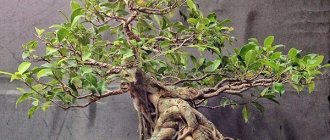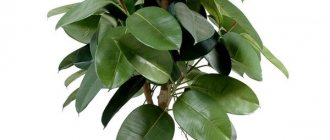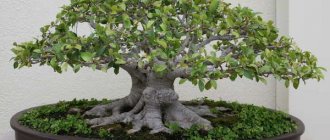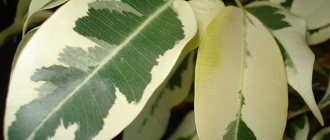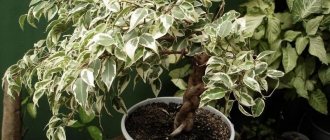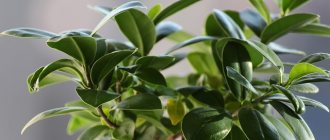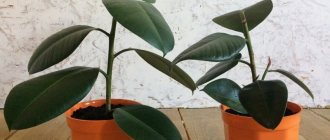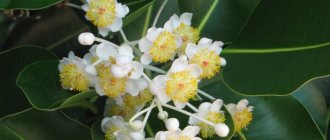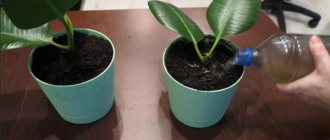Ficus microcarpa is one of the extraordinary representatives of tropical flora, which is perfect for indoor floriculture. Caring for it is not difficult. However, in order for this highly decorative tree to become an interior decoration, you will have to get to know it a little better.
| general description | |
| Family: | Mulberry |
| Name in Latin: | Ficus microcarpa |
| Growing in nature: | Tropical Asia, South China, Australia, Taiwan. |
| Toxicity/toxicity: | When pruned or handled carelessly, the plant releases toxic juice, which causes irritation if it comes into contact with the skin. It is also not recommended to grow Ficus microcarpa for people suffering from allergies. It can cause the greatest harm to the health of asthmatics, provoking attacks of bronchial asthma or swelling of the mucous membranes. |
| Difficulty in care: | Due to the ease of care, it is suitable for growing for beginners. The tree is absolutely not picky about its maintenance, if you provide it with minimally comfortable conditions. |
| Plant size at home: | It grows above 30 cm. In isolated cases, when creating ideal conditions, it can reach a height of 1.5 m. |
| Content temperature: | The most comfortable temperature for keeping is 17-23°C. In addition, the tree has an extremely negative attitude towards sudden changes in temperature and sheds its leaves. |
| Watering: | Watering is preferable in moderation with warm, settled water after the soil has dried 2-3 cm deep. |
| Lighting: | Prefers moderate lighting, but will grow well in the back of a room with diffused sunlight. |
| Indoor humidity: | Throughout the year it needs high levels of humidity. |
| Bloom: | Only a few lucky owners of microcarp have had the opportunity to observe its flowers with their own eyes: brown, with a green center in the center. In its natural environment, the tree blooms annually and produces quite edible, but tasteless fruits. |
| Rest period: | From November to March the plant rests and stops active development. |
| Reproduction methods: | Cuttings, shoots, less often - seeds. |
| Frequency of transplantation: | The young tree must be replanted into a larger pot every spring. In the future, this process can be repeated once every 2-3 years. |
| What soil to choose: | The best soil for ficus microcarp will be a ready-made soil substrate intended for palm trees and ficus trees. But you can prepare the ground for planting yourself if you add turf soil, humus, peat and sand in equal proportions. |
| Fertilizer: | Ficus microcarpa needs feeding twice a month throughout the spring-summer period. In the autumn-winter period, they can be reduced to 1 time for the same period. You can use a universal complex fertilizer or a special fertilizer for ficus plants. |
Ficus microcarpa Ginseng bonsai care at home. Description
Ginseng, also known as microcarpa or small-fruited ficus, belongs to the Mulberry family.
In Latin, its scientific name is Ficus microcarpa ginseng.
In natural conditions, it is an evergreen tree 15-25 meters high with a dense spreading crown, a powerful trunk and huge aerial roots hanging down.
In indoor culture, it is most often grown in the form of a bonsai with a small trunk, but a huge rhizome, shaped like a ginseng root. It is no coincidence that “ginseng” is translated as “ginseng”. The tropics and subtropics of Southeast Asia are the tree’s usual habitat.
This representative of the flora is also called “Indian laurel”, “green island” and “Chinese banyan”.
Its dark green leathery leaves are quite large - up to 15 cm in length.
They are oval in shape and have a glossy surface.
Ginseng is a strangler ficus.
Starting life as an epiphyte, as it develops it takes root next to the host tree, entwines it and strangles it, preventing it from developing.
The bizarre rhizome for which the indoor ficus ginseng is famous does not occur in nature.
It is grown on farms using a special technology that is kept secret.
The tree is fed with special preparations and kept in special conditions.
When the root reaches the desired thickness and shape, the plant is transplanted into another container, leaving most of the rhizome on the surface of the soil.
At the same time, the trunk is cut off and new greenery is grown.
Indoor forms with an ordinary trunk are also bred on farms.
In this case, the rhizome is hidden in the ground and the main beauty of the tree is given by the luxurious dense crown.
Charming bonsai trees will not leave anyone indifferent. Most of all, gardeners loved the following tree-like ficuses: Benedicta, Bengal, Carica, Lirata, Microcarpa, Eden, Large-leaved, Impatiens, Retuza and Obtunded. You will find all the rules for growing them on our portal.
Description
Ficus microcarpa in its natural habitat is a large epiphytic plant . Settling on large trees, it grows quickly, forming a lush crown and long, but powerless roots. Hanging from tree branches, they present a very interesting sight (see photo).
The height of the plant growing in tropical forests can reach 20 meters. Indoor specimens reach 1.5 meters, but most often they are grown in the form of small original bonsai, gradually exposing the roots and regularly pruning the shoots.
The trunk of this ficus is characterized by gray bark; it has a very smooth, thin and delicate structure, so when growing indoors you need to handle it carefully so as not to damage it. The shoots of the plant are covered with small foliage, which can have an elliptical, oval or round shape.
During flowering, ficus microcarpa is covered with flowers of an unusual shape, reminiscent of berries (syconia). Subsequently, very small fruits no more than 1 centimeter in diameter are formed in their place. That is why this type of ficus got its name, the translation of which sounds like “small-fruited”.
Often on the pot of a purchased plant they also write Ficus microcarpa Ginseng, or Ficus ginseng i.e. "ginseng". These ficus trees are grown in a special way . After planting a ficus, it very quickly forms a root, the growth of which is stimulated by special means and hormones.
When the root reaches a significant size, the ficus is dug up, the trunk is cut off, cleaned and planted in pots, leaving the root above the surface of the soil, only slightly buried.
Over time, the skin of the roots hardens and turns into bark.
The growth of a new shoot is also stimulated with chemicals or by grafting branches of other plants.
At this stage, the plants appear on store shelves in the form of a small tree with a large root.
To grow bonsai in the future, agents are used that slow down the growth of ficus.
Ficus microcarpa Ginseng home care forum. Ficus ginseng care at home
Ginseng or ficus microcarpa ginseng is a species of ficus plant belonging to the Mulberry family. The similarity of the presented flower with ginseng lies only in the thick trunk, which looks like a root. Although it is very difficult to create a “mandrake root system” at home.
In nature, this species can reach a height of 25 meters. As for home conditions, we are usually talking about dwarf plants that look like bonsai.
For good growth, ficus needs to create optimal conditions, which include:
- choosing the right microclimate;
- high-quality watering;
- competent feeding.
The right microclimate - what is it like?
Ficus ginseng does not tolerate direct sunlight, so you should not place a flower pot on a windowsill where the sun constantly shines.
However, it is also impossible to hide the plant in the shade. It is advisable to give the flower a bright, but not brightly lit place, where the temperature will not drop below +16..+18 °C. Important! Ficus is a flower that does not like to be moved, so it should not be carried from place to place.
High-quality watering
Many gardeners make a big mistake by watering a flower with tap water, believing that nothing bad will happen, since rainwater is no cleaner. Perhaps, but it does not contain chlorine and salts that negatively affect the soil and the entire plant. At home, you should water the flower only with settled, melted, rain or purified water.
And the manipulation is performed as follows:
- The procedure begins only when the substrate in the flowerpot dries 2-3 cm deep.
- The flower loves spraying, but it is advisable not to water the aerial roots and trunk abundantly. It is recommended to wipe the sheet plates with a wet cloth from time to time.
- If it is desirable to carry out irrigation daily, then the plant should be watered no more than twice a week in the summer, and no more than once every 10-14 days in the winter.
Particular attention should also be paid to the air humidity in the room, which should be at least 50%.
Fertilizer application
Without fertilizing, not a single flower will grow and delight the grower with the splendor of its crown or the abundance of flowers. And although ficus ginseng does not bloom at home, it can boast of the rich color of its leaf plates. Therefore, it is necessary to fertilize the pot with the plant once every 2 weeks, alternating organic matter with mineral fertilizers.
Ficus transplant
A young flower is replanted every year; a plant that has reached two years of age needs the procedure every 2-3 years.
By the way, it is absolutely normal if the leaves of a flower you just bought and brought home begin to fall off. This is how the plant reacts to changing conditions.
When replanting ficus microcarpa ginseng, it is important to use special soil. It can be neutral or slightly acidic. A similar substrate is sold in flower shops, but you can make it yourself.
In order to do this, you will need to take:
- sand – 1 part;
- leaf soil - 2 parts;
- turf soil - 2 parts.
Some gardeners also add peat soil or charcoal to the composition. Having mixed it all thoroughly, we can assume that the soil mixture is ready.
There is an opinion that there is no need to replant ficus ginseng bonsai. They say it is enough to trim the roots. It is not true. Considering that the presented type of ficus, like all others, contains poisonous juice, which gradually affects the composition of the substrate, replanting should be performed without fail.
Methods for creating ginseng bonsai
It’s hard to argue with the fact that ficus ginseng looks amazing as a bonsai. It is not surprising that many gardeners strive to give their flower exactly this shape. Moreover, it is not difficult to do this. First the trunk is formed. To do this, you can carefully tie the top of the crown to the trunk with threads, and then very carefully tie the entire ficus with wire.
After 2 months, this entire structure is removed. This procedure will create special scars that decorate the plant.
As for the crown, it is formed just as simply. If you want to get a ball shape, then the side shoots are regularly cut off, and the upper branches and leaves are pruned. We must remember to thin out the crown so that the shoots do not create an unnecessary “forest” inside.
Flower propagation methods
If you know how to care for a plant, you can get not only a beautiful bush, but also the opportunity to grow ficus trees.
The most popular methods are:
- propagation by cuttings;
- propagation by root cuttings;
- propagation by air layering.
Propagation by cuttings
This type of reproduction is performed in the following order:
- In spring, it is necessary to cut cuttings with several leaves from the tops.
- After this, the shoots should be placed in water for 2 hours, which will need to be changed periodically.
- Next, the cuttings are placed in a pre-prepared substrate and covered with a bag.
The gardener should place the flowerpot with cuttings in a bright and warm room. At this stage, the rules of care are reduced to ventilating the greenhouse and brief watering.
After 2-3 months, when the cuttings take root, they can be planted in new pots.
Propagation by root cuttings
In order to propagate a flower in this way, you should cut off part of the root from an adult ficus, and then place it in water for several hours. Next, the root is planted in a peat-sand mixture and covered with film.
When the first leaves appear, the film can be removed, and after a while the young plant can be transplanted into a flowerpot.
Reproduction by air layering
This method is not used as often as the others. To begin with, the gardener must make a small cut around the bark, apply moistened moss on top and then wrap the whole thing with film.
Important! It is necessary to keep the sphagnum wet, and do not forget to ventilate such a greenhouse.
When roots appear, the top is cut off and transplanted into a separate container.
Simple rules will allow the gardener to grow a beautiful ficus ginseng.
Description and characteristics of the Microcarpa variety
The name Microcarp translated from Greek means “small fruit”. However, at home you will not be able to admire the flowers and fruits of the plant, since there are no conditions for pollination. In the wild, the plant produces small, inconspicuous flowers that are pollinated by the Parapristina verticillata wasp. As a result, it produces berry-like, inedible fruits.
Ficus is a tree with a thickened, massive root located above the soil. The root of the plant is more like a tree trunk with smooth, grayish-brown bark.
Microcarpa branches well, forming a luxurious crown with oval-elliptical dark green leaves above the trunk. The length of the leaves is 12-15 cm, width - from 2 to 7 cm. They are located on the branches alternately, in a certain order, attached by short petioles (no more than 5 cm).
Ficus microcarpa Ginseng home care. Reproduction
Ficus Ginseng can be propagated in three different ways: cuttings, seeds or air layering. It is almost impossible to sow microcarpa at home, so gardeners are left with the two methods described above.
- You can grow your own bonsai from cuttings. At the very beginning of spring, branches that have already become covered with hard bark are cut off and placed in a vessel with water for the next two weeks. In the first 1-2 days, the plant will release milky sap, which helps heal wounds and inhibits root growth, so the water needs to be changed at least twice a day.
- Reproduction by air layering is a more complex, but most effective method. On one of the strengthened branches of Ginseng, the bark is cut off (in a rectangle of approximately 2-3 centimeters). Afterwards, the cut site is wrapped in damp moss, covered with film and left in this state until the roots sprout. Then the cellophane is removed, the seedling is cut and planted in the ground immediately with moss, which will act as a natural fertilizer.
- Root cuttings are another method of propagating ficus plants. This method is the simplest, but not all seedlings take root. It is necessary to separate approximately a quarter of the rhizome. Afterwards, the roots are transplanted into a separate pot. The cut piece should protrude about 2-3 centimeters from under the ground.
Reproduction
Ficus reproduces quite easily. Each gardener can choose the most convenient option for himself. But it is important to remember that a cutting grown from a bush does not form basal thickenings.
Cuttings
For cuttings, you need to choose semi-lignified apical shoots. You need to cut cuttings from them at an angle. The length of the cuttings should be about 10-15 cm. It is necessary to cut off excess leaves from below, leaving 2-3 pairs. Next you need to do the following:
- Place the cut side of the cutting in water for a day to release the juice.
- Prepare new water with crushed coal and leave the shoot there for germination.
- When several roots appear, transplant into a light substrate and cover with a jar. Moisten as needed and ventilate.
- When the first leaves appear, remove the jar and plant the plant in a permanent pot.
Root cutting
This method is used during plant transplantation. The cuttings need to be planted in the ground, leaving about 3 cm on the surface. Cover with film. Don't forget to water and ventilate regularly. In about 3 months there will be rooting, you can understand that it has happened by the formation of new shoots. When 4 leaves appear on the cuttings, the cover can be removed.
By layering
- Step back 50-70 cm from the top and cut off the bark along the entire circumference of the trunk at the selected location.
- Wrap the wound in damp sphagnum moss, cover the top with a film with holes made for air, and secure.
- Water the cut using a syringe.
- When roots begin to grow through the moss (30-40 days later), remove the film.
- Cut off the top under the new roots and replant.
Seeds
This option for propagating ficus microcarpa is the most popular, because the seeds have low germination capacity and the seedlings grow rather slowly. Propagation by seeds includes the following steps:
- Seeds need to be treated with a growth stimulator solution.
- For germination, you need to make a mixture of peat and sphagnum and fill it with a shallow container with holes.
- Place the seeds on a damp substrate and sprinkle with sand. Keep covered with film in a warm and bright place.
- When 2-3 leaves appear, pick them up into separate pots.
Caring for ficus microcarpa Ginseng. Care at home
Ficus microcarpa does not require complex care. This flower prefers bright, diffused sunlight. But you can also choose artificial lighting for it. It is placed closer to the window, but away from heating sources. The optimal temperature in summer is considered to be 20–23 degrees Celsius. In winter, the indicator should not be less than 16. If the summer is very hot, care includes constant ventilation and spraying. The plant needs a lot of moisture during the period of intensive growth.
In winter, the reference points are air humidity, temperature and degree of illumination. When kept in a cool, dark room, the need for water is reduced significantly. Ficus microcarpa ginseng loves high air humidity - spraying should be carried out 1 - 2 times a day. And once every 2-3 weeks the culture is washed under a warm shower. To increase humidity when caring for a plant, a tray with wet expanded clay is often used.
The culture requires well-drained, soft and fertile soil with a slightly acidic or neutral reaction. You don’t have to buy ready-made soil, but prepare it at home by taking turf, leaf, peat soil and sand in equal parts, adding charcoal. Care includes applying complex fertilizing once every 2 weeks. Universal fertilizers are recommended for decorative foliage plants or bonsai. In winter, 1 feeding per month is enough. Ficus microcarpa responds positively to foliar feeding. Care involves replanting young specimens once every 2 years with a complete renewal of the earthen layer.
Possible problems
If the ficus microcarpa is not cared for correctly, it may develop problems such as:
- Thin stems with excessively small leaf blades are formed . Too little lighting and lack of nutrients.
- Suddenly, green leaves flew around . A sharp jump in temperature, stagnation of moisture in the roots, moving to a new location, moistening the substrate with cold water or the influence of a draft.
- The foliage turned yellow and flew off . Poor lighting, acute lack of water, excessively low air humidity, or the plant needs urgent feeding.
- Yellowing of leaf blades . The bush feels an acute lack of moisture or, on the contrary, it stagnates in the root system; this may also be due to a lack of microelements.
- Gray spots have formed on the leaf blades . Due to regular stagnation of water in the soil, rot appeared on the root system. Cut out all affected parts of the roots, treat the bush with a fungicidal preparation, then plant it in fresh, well-drained soil mixture, and also make a better drainage layer.
- The foliage is curling . The plant received sunburn.
- Pests . Mealybugs, scale insects and aphids can settle on the tree. Give the infected plant a warm shower, and then treat it with an insecticidal solution.
Ficus bonsai microcarpa Ginseng. Bonsai Ficus Ginseng
1
Ficus Ginseng, or Ficus microcarpa, or Ficus obtuse in natural conditions reaches 25 meters in height. In foreign literature it is called Indian laurel, green island and Chinese banyan. In his homeland - in East Asia, on the island of Borneo - he is called the Strangler. Ficus, with the help of aerial roots, wraps itself around the trunks of neighboring trees and interferes with their growth - “strangles”.
- In the wild, ficus Ginseng is found in Southeast China, Japan, the Philippines, Taiwan, Indonesia, and Northern Australia. It grows very quickly and is unusually hardy. Ficus sprouts in all places it finds itself: in sidewalk cracks, on rocks, on the roofs of multi-story buildings.
- picking soil, sand and clay granules in equal quantities;
- turf soil, leaf soil and sand (in a ratio of 2:2:1), you can add charcoal;
- turf soil, peat soil, leaf soil and sand in equal parts.
- change of conditions;
- draft;
- sudden changes in temperature;
- excessive watering and root rotting.
miniature tree
In indoor conditions it is grown as a bonsai, the height of which does not exceed 50 centimeters. Recently, it has become fashionable to give bonsai as a gift. Although this plant is an oriental one, having recently appeared in the CIS countries, it has managed to win a place for itself in our souls. Ficus Ginseng is often called ginseng. It was given this name because its root is similar in appearance to ginseng root or the fabulous mandrake root. A small tree with a bizarrely curved trunk was especially loved by men.
But it should be noted that such a trunk was not given to it by nature, but was formed using special agricultural technology.
Bonsai blooms with small spherical inflorescences painted purple. The inflorescences are about 2 centimeters in diameter and resemble berries. Later, real berries are formed from the flowers. They are not used for food: ficus berries are not poisonous, but have a disgusting taste. But at home, ficus flowering is very rare.
Location
Did you receive a Ficus Ginseng as a gift? Let's find a permanent place for it, protected from direct rays, but not completely dark. The best choice for the plant would be partial shade. Ficus does not like drafts, but there is no place for it near a radiator. The optimal temperature for ficus is +16…+22C. What he doesn't like most is sudden temperature changes.
In summer we take the flower out onto the balcony or veranda.
Ficus care
Ficus Ginseng is not picky and does not require special conditions.
Watering
Despite its small growth, the plant has huge aerial roots and loves moisture. Water as needed, not allowing the earthen ball to dry out. But ficus does not like waterlogged soil. For irrigation we use only settled water.
We spray the bonsai and wipe the leaves with a damp cloth every day.
It's okay if the leaves start to fall - this is a reaction to the new conditions. With proper care, the bonsai will produce new leaves. To help him adapt faster, we spray him with an epin solution.
Top dressing
During the period of active growth (spring-summer), we feed it twice a month with full mineral fertilizer and organic fertilizer, alternating them. Yellowing of the leaves indicates a lack of minerals.
Transfer
Every spring until the age of 5, we transplant it into a new container. Then we carry out transplantation once every 2-3 years. When replanting, shorten the ficus root by a third.
For planting, we take purchased soil for ficuses or prepare the soil ourselves.
Substrate options for planting:
We pour expanded clay onto the very bottom of the flower pot, and crush the top of the soil with sand.
Trimming
We form the crown after 3-4 years, leaving 3-4 leaves on the branches. The plant tolerates pruning easily. If the ficus is not trimmed, it will stretch out and lose its resemblance to a bonsai. We monitor the appearance: promptly remove damaged and dried shoots.
Pests and diseases
Sometimes ficus is attacked by mites, scale insects, whiteflies, aphids, and thrips. In this case, we treat the plant with Actellik.
The green leaves on the ficus may suddenly fall off. The reasons for this phenomenon:
If yellow leaves fall off, this phenomenon indicates:
- insufficient watering;
- dry air;
- lack of sunlight;
- lack of minerals.
Reproduction
With proper care, Ficus Ginseng will delight you with its appearance for a long time. You can grow it yourself from cuttings, root suckers, air layering or seeds. But with independent propagation, an ordinary ficus will grow. You won't be able to get a bonsai.
If you decide to grow a ficus from a cutting, you should not overwater it. In case of excessive moisture, the cuttings rot. Cut the cuttings to a length of 10 centimeters, leaving 3 pairs of leaves. We process the cut using root or heteroauxin. We plant the cuttings in the soil-sand mixture and cover with a jar. After rooting, we transplant it to a permanent place of growth.
This hardy, original and distinctive plant will charm you and become your favorite.
Diseases and care problems
All problems and diseases of ficus microcarp are primarily associated with incorrect or insufficiently good living conditions.
- Dropping leaves and/or buds - insufficient feeding or lighting.
- Pale leaves are a lack of sun.
- Drying leaf tips are a sign of a lack of fertilizer or moisture (or too much).
- Falling of the lower leaves, gray spots - likely the appearance of rotting roots.
- Curling leaves - sunburn.
Also read: Adenium - an amazing African mini-tree
Eliminate the mistakes you made in growing the plant, carry out sanitary pruning of the affected branches and it will again delight you with beautiful leaves and a lush crown.
Also read a useful article on this topic: “Fungicides and fertilizers suitable for cacti and succulents.”
Insect pests
If your ficus is attacked by scale insects, mealybugs or aphids, you will need to save the plant from certain death. First you need to try to remove pests as much as possible manually. Then cover the soil of the pot with film and put the tree under the shower to wash off the remaining insects with water at room temperature and prevent them from reaching the surface of the soil.
In conclusion, treat with insecticides that are suitable for controlling detected pests. Read about when and what medications to use here.
Ficus Ginseng transplant after purchase. Benefits and harms
- Ficus ginseng is not only a beautiful ornamental plant, it has numerous beneficial properties:
- rids the air in the apartment of harmful substances - phenol, benzene, formaldehyde fumes;
- saturates the air with oxygen;
- has a beneficial effect on the energy of the room.
In addition, it is widely used in folk medicine for the treatment of diseases such as mastopathy, fibroids and other neoplasms. Tinctures based on the milky juice of the plant are used in the complex treatment of arthrosis, radiculitis, and osteochondrosis.
From the frozen milky juice of ficus, lotions are prepared for hematomas, bruises, warts and papillomas. Medicines are also made on its basis, for example, suppositories for hemorrhoids.
In most cases, ginseng is safe for people, but experts do not advise growing the plant for those who are prone to allergic reactions. The milky sap secreted by the tree can provoke the development of rhinitis, fever, and headaches.
Did you know? In the list of the most powerful household allergens, ficus is in third place, losing first place to pets and dust mites.
Appearance
If we talk about the wild ficus Microcarpa, which is native to Asia, China and Australia, it reaches impressive sizes. Some specimens grow up to 25 m in height, but the indoor plant is just a miniature copy of the wild ficus. Its height rarely exceeds 150 cm. And when forming the crown, you can always adjust the height of the tree.
The decoration of the ficus Microcarp is not the lush crown or flowers of extraordinary beauty, but the part of the root system located above the surface of the earth. It is difficult to find 2 plants whose exposed root system takes the same shape. Accordingly, you can keep several Microcarp ficuses in the house, which will not be similar to each other.
The leaves of the plant are small, resembling an ellipse in shape, one part of which is slightly pointed, and the second remains round. The leaf sizes do not exceed 10 cm in length and 5 cm in width. These are the maximum figures. If we talk about averages, the leaf length is 7 cm and the width is 3 cm. Like many ficuses, the leaves of this flower have a glossy surface. The light green leaves are arranged alternately on the stem, forming a beautiful and dense crown.
Flowering and dormant period
Ficus microcarpa flowers are a rare occurrence in apartment conditions. However, the owner may be lucky and observe this process. Bonsai is a dioecious plant, that is, only female or male inflorescences can appear on one tree. Consequently, the tree will not be pollinated without someone else's help.
During the flowering phase, syconia appear on the ficus - small inflorescences closed in a box. It is they that are pollinated by wasps in their natural environment; pollen from insects penetrates into the hole of the syconium, inside which the fruit begins to form. At the first stage, the box turns golden, then develops into burgundy or cherry.
The ficus sleep phase begins in mid-autumn and ends in early spring. In order for the tree to survive this period as safely as possible, you need to reduce watering and fertilizing, and also lower the temperature by 15 degrees Celsius.
Diseases and pests
Ficus microcarpas, which are bred indoors, are quite resistant to insects and diseases. Problems most often arise if the air in the room is too dry or the temperature is high . Pests may move from other flowers if there are too many of them or they are crowded.
Why does it shed its leaves?
Experienced gardeners know that ficus microcarpas shed their foliage for several reasons:
- there is too little moisture in the air;
- temperature too low;
- backlight required;
- there is not enough moisture in the soil;
- Cold water was used for irrigation.
Leaves also fall off after rearranging or moving, due to sudden temperature changes and drafts.
The leaves are turning yellow
In dry air, poor watering, and insufficient lighting, the leaves turn yellow before falling.
The lower ones change color due to lack of nutrients. If there is stagnant water in the soil, the leaves first become covered with gray spots, then turn black. It is necessary to remove the tree from the pot, remove rotten roots, and treat the rest with an antifungal agent. Before transplanting into a new soil mixture, you need to calcine it or disinfect it with potassium permanganate.
Spider mites and scale insects
Among the insects, ficus plants are affected by spider mites and scale insects.
Spider mites appear as spider webs. First, the foliage is treated with a solution of laundry soap, and the crown is washed in the shower. It is advisable to transplant the tree into new soil. If these measures are ineffective, you should buy an insecticide.
When attacked by scale insects, the foliage becomes sticky. The sequence of actions is the same as for spider mite infestation.
Many believe that ficus microcarpa absorbs toxins into the leaves, purifying the air in the room, improving the energy of the home, helping to stabilize family life, and attracting good luck.
You should not buy this plant if you have an asthmatic in the family, or use the juice for treatment. If the tincture is prepared incorrectly, it can be harmful.
Pruning and crown formation
Pruning must be done in order for the ficus to form a beautiful crown. But crown formation is not the only goal pursued by pruning. At the same time, the tree is rejuvenated. Pruning is done twice a year: in spring and autumn.
There are no specific pruning rules. It all depends on how each tree grows and what shape you would like to see. During the formation of the crown, it is necessary to ensure that the length of the branches does not differ greatly. Otherwise, the tree will look sloppy. If some branches are growing at a rapid pace, then pruning can be done unscheduled. It is worth considering that the more often the branches are pruned, the smaller the leaves that grow on them will be.
If pruning is not done in a timely manner, the trunk will not thicken, which should also be trimmed periodically. They do this so that the lower part thickens faster.
How often to change the soil and replant the plant
It is recommended to replant Microcarp after purchase, since the soil in which it was kept in the store most often does not meet the necessary soil characteristics. However, replanting should not be rushed, as the tree is under stress and may begin to shed its leaves after moving to a new location. You need to wait two weeks - and only after that replant the tree in suitable soil.
Another reason for replanting is excessive growth of roots, which can even grow through the drainage holes of the pot or grow tightly into the earthen lump. A young plant must be replanted once a year, and when it turns four years old, replanting is already carried out as necessary.
Typically, an adult Moklama is replanted once every three years, since the soil in the pot is gradually depleted and needs to be replaced with fresh one, and the replanting itself is carried out by transferring the tree from one pot to another, preserving the root system in an earthen coma. The optimal time for such an event is early spring.
Correct lighting
For this home plant, proper and timely lighting plays an important role. As we already know, ficus does not tolerate direct sunlight, therefore, the place where the plant is supposed to be placed should be light enough, but darkened from the sun. Ficus microcarpa does not like to change its permanent location. If the plant is frequently rearranged, it can shed all its leaves, and then you will have to wait quite a long time for their reappearance.
To maintain a beautiful and dense foliage cover of a tree, you can use special biostimulants for foliage growth.
Subtleties of watering
Although this representative of the flora loves high humidity, it must be watered very carefully. After all, when excess water forms in the soil, the processes of rotting of the root system begin, which will ultimately lead to the death of the plant.
The first sign that the plant needs watering is soil that has dried 2-3 cm deep. For irrigation, you can use rain or settled water, but be sure not below room temperature. If the water is very cold when watering the plant, the plant will experience stress and shed its foliage. Be sure to keep an eye on the pan; there should be no excess liquid there, and if there is any, it must be drained.
There are no specific recommendations on the bonsai watering schedule, because each case has its own microclimate, which affects the frequency of watering the plant.
Signs and superstitions
The Slavs have always had a negative attitude towards the presence of ficus trees in living rooms, believing that they have a bad effect on humans. Other peoples consider ficus a tree that cleanses the aura and protects from evil spirits.
Microcarpa is an unusual ficus grown using the bonsai technique. Caring for it is easy. In captivity, ficus blooms in the rarest of cases, but even if this happens, the flowering does not carry decorative value.
Sources
- https://bonsai-doma.ru/rukovodstvo/bonsai-microcarpa/
- https://komnatnie-rastenija.ru/fikus-mikrokarpa-uhod-i-razmnozhenie-v-domashnih-uslovijah-foto-rastenija/
- https://ufermer.com/komnatnye-rasteniya/fikus/opisanie-mikrokarpa-moklame.html
- https://agronomu.com/bok/6273-vyraschivanie-i-uhod-za-fikusom-moklame-v-domashnih-usloviyah.html
- https://pro100ogorod.ru/tsvety/fikus-moklame.html
- https://pocvetam.ru/komnatnye-rasteniya/dekorativno-listvennye/fikus-moklame.html
- https://zen.yandex.ru/media/id/5cc410d110654100b2d87c08/5cc5e1118e370c00b367022b
- https://fermer.blog/bok/komnatnye-rasteniya/dekorativno-listvennye/derevya/fikus/vidy-fikusov/1687-fikus-mikrokarpa-moklame.html
- https://selo.guru/rastenievodstvo/dekorativnolistvennye/derevjya/fikus/vidi-f/mikrokarpa.html
- https://InfoDacha.com/mir-cvetov-vidy-posadka-i-uhod-udobreniamir-cvetov-vidy-posadka-i-uhod-udobreniafikus-mikrokarpa/
- https://dm-st.ru/iskusstvo-sozdaniya-derevtsa-bonsay-iz-fikusa
- https://pocvetam.ru/komnatnye-rasteniya/dekorativno-listvennye/fikus-mikrokarpa.html
[collapse]
How to form a bonsai with a thick trunk from Ginseng?
The formation of a thickened trunk is best done in young trees. The root system of this type of ficus is powerful, and thickened roots are formed underground.
Pruning the root system and shoots is combined with transplanting into a new container:
- Ficus Ginseng is removed from the pot, the roots are freed from the ground and washed in water at room temperature.
- Use pruning shears or scissors to trim the roots. Some gardeners advise cutting off 30% of the length. Others advise removing no more than 10%. Dried, dead and thin living roots are removed completely.
- The sections are treated with crushed activated carbon.
- The plant is planted in a pot. The upper roots are left above the soil surface (a third or half of what will remain in the ground).
- The trunk is cut off at a distance of 4.5-5 cm above the root collar.
- The cut is sprinkled with coal dust.
- When the shoot grows and lengthens by 5-6 cm, the pruning is repeated. With this procedure, the roots thicken, and the plant takes on the characteristic shape of a Ginseng bonsai.
- The trunk stops being cut when the required thickness of the above-ground roots is reached.
- After some time, the plant throws out shoots and leaves.
Active pruning of the crown is carried out in spring or summer, when 6-10 leaves grow on the branches. After formation, at least 2-4 leaves are left on the shoot.
The branches grow unevenly, and the crown can be trimmed constantly. You should not cut the leaves in half in an attempt to achieve ideal shapes; only cut off the branches.
Ficus Microcarpa Ginseng is unpretentious and easy to care for. This flower has a sophisticated, modern look. Bonsai with a mandrake-like root fits perfectly into any interior style.
Bonsai from other types of ficus: Bengal, Fig, Panda, Rubber, etc.
You can create an original and spectacular bonsai from other types of ficus, but you need to take into account some nuances:
- Bengal ficus. It is also called banyan because of its specific shape: one plant looks like a whole grove. This is why the Bengal ficus is valuable among bonsai lovers. You can also form a grove from other species, but it is easier to get a bonsai from the Bengal ficus, and it will look more impressive. Leaves with a variegated pattern will add decorativeness to the composition.
- Ficus Panda has very dense leaf plates, giving the bonsai a special originality. The tree tolerates dry air very calmly, so it will take root well in a city apartment.
- Fig ficus, or Carica (wineberry, fig tree). This species has thick branches, so pruning the plant is difficult. The leaves are large, but decrease in size over time - this is a plus for bonsai. The downside is that the fig ficus sheds its leaves in the winter. But in the summer it quickly gains new strength, especially if it is taken out into the open air.
- Ficus rubber plant. Not all representatives of this species are suitable for creating bonsai. Experts prefer to use specially bred hybrids with different color patterns on the leaves. The leaves of the rubber ficus grow quickly and are arranged in a spiral, which is good for the formation of a bonsai tree. The plant is demanding of lighting and does not tolerate changing it, so you should keep the rubber ficus bonsai in the same place. Do not forget that the juice of this species is poisonous: do the pruning with gloves and sprinkle the cut areas with activated carbon.
- The rusty-red ficus is distinguished by smooth reddish bark and leaves covered on the inside with red hair. This species grows very slowly, but you do not have to do frequent pruning. The stems of the Rusty Red Ficus, like the Ficus Bengali, form a banyan tree, but not very pronounced. The plant is very hardy, mistakes in care are not critical.

